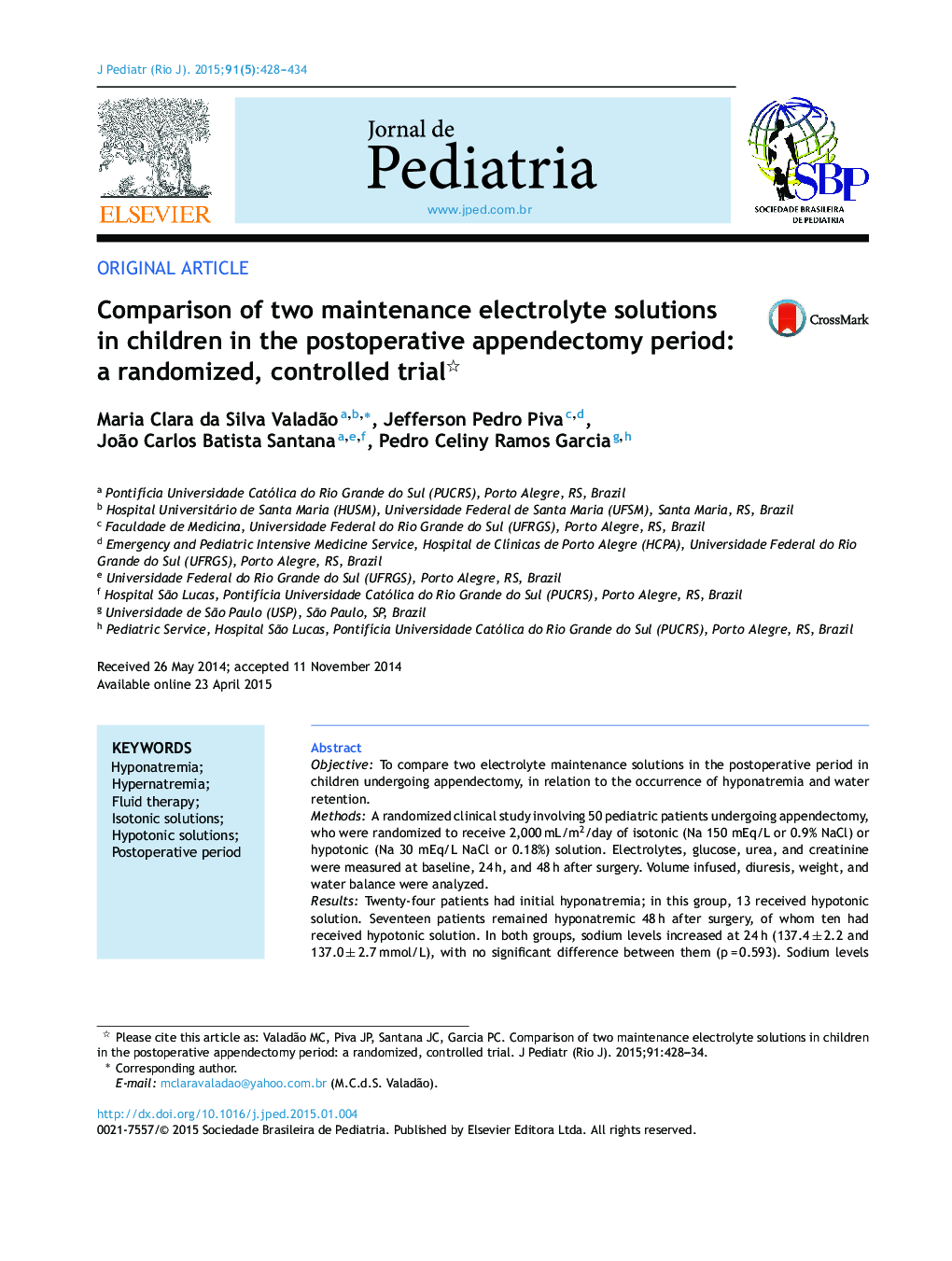| کد مقاله | کد نشریه | سال انتشار | مقاله انگلیسی | نسخه تمام متن |
|---|---|---|---|---|
| 4153896 | 1273681 | 2015 | 7 صفحه PDF | دانلود رایگان |
ObjectiveTo compare two electrolyte maintenance solutions in the postoperative period in children undergoing appendectomy, in relation to the occurrence of hyponatremia and water retention.MethodsA randomized clinical study involving 50 pediatric patients undergoing appendectomy, who were randomized to receive 2,000 mL/m2/day of isotonic (Na 150 mEq/L or 0.9% NaCl) or hypotonic (Na 30 mEq/L NaCl or 0.18%) solution. Electrolytes, glucose, urea, and creatinine were measured at baseline, 24 h, and 48 h after surgery. Volume infused, diuresis, weight, and water balance were analyzed.ResultsTwenty-four patients had initial hyponatremia; in this group, 13 received hypotonic solution. Seventeen patients remained hyponatremic 48 h after surgery, of whom ten had received hypotonic solution. In both groups, sodium levels increased at 24 h (137.4 ± 2.2 and 137.0 ± 2.7 mmol/L), with no significant difference between them (p = 0.593). Sodium levels 48 h after surgery were 136.6 ± 2.7 and 136.2 ± 2.3 mmol/L in isotonic and hypotonic groups, respectively, with no significant difference. The infused volume and urine output did not differ between groups during the study. The water balance was higher in the period before surgery in patients who received hypotonic solution (p = 0.021).ConclusionsIn the post-appendectomy period, the use of hypotonic solution (30 mEq/L, 0.18%) did not increase the risk of hyponatremia when compared to isotonic saline. The use of isotonic solution (150 mEq/L, 0.9%) did not favor hypernatremia in these patients. Children who received hypotonic solution showed higher cumulative fluid balance in the preoperative period
ResumoObjetivoComparar duas soluções de manutenção hidroeletrolítica no período pós-operatório (PO) de crianças submetidas à apendicectomia, quanto à ocorrência de hiponatremia e retenção hídrica.MétodosEstudo clínico randomizado envolvendo 50 pacientes pediátricos submetidos à apendicectomia, randomizados a receber 2000 ml/m2/dia de solução isotônica (Na 150 mEq/L ou NaCl 0,9%) ou hipotônica (Na 30mEq/L ou NaCl 0,18%). Eletrólitos, glicose, ureia e creatinina foram mensurados no início do estudo, 24 e 48 horas após a cirurgia. Foram analisados volume infundido, diurese, peso e balanço hídrico.Resultados24 pacientes apresentaram hiponatremia inicial, destes 13 receberam solução hipotônica. Dezessete pacientes permaneceram hiponatrêmicas 48 horas após a cirurgia, 10 haviam recebido solução hipotônica. Nos dois grupos os níveis de sódio aumentaram na 24ª hora PO (137,4 ± 2,2 e 137,0 ± 2,7), não havendo diferença entre eles (p = 0,593). Níveis de sódio 48 h após a cirurgia foram 136,6 ± 2,7 e 136,2 ± 2,3 no grupo isotônico e hipotônico respectivamente sem diferença significativa. Os volumes infundidos e diurese não diferiram entre os grupos durante o estudo. O balanço hídrico foi maior no período anterior à cirurgia no grupo de pacientes que receberam solução hipotônica (p = 0,021).ConclusõesNo período pós-apendicectomia, o uso da solução hipotônica não aumentou o risco de hiponatremia, quando comparado a uma solução salina isotônica. O uso da solução isotônica não favoreceu a hipernatremia nestes pacientes. Crianças que receberam solução hipotônica apresentaram maior balanço hídrico cumulativo no período pré-operatório.
Journal: Jornal de Pediatria - Volume 91, Issue 5, September–October 2015, Pages 428–434
